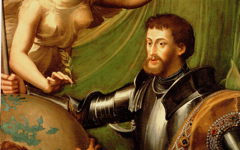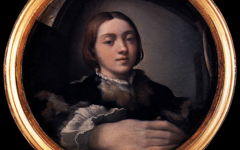Parmigianino’s Man with a Book (1523-4) with works by Titian and Michelangelo too
James Hall recently argued that where others see just the likeness of a man in Parmigianino's Portrait of a Man with a Book (1523-4), he sees a spiritual allegory masked as a likeness. He points out, for instance, that the man's left eye in darkness is not even there.1
Click next thumbnail to continue
A close-up look at where the eye ought to be shows what he means. He added that in the Renaissance the right eye was considered the spiritual eye while the left one looked out onto worldly matter. We here have argued for some time that, in many portraits by many different artists over the centuries, one eye sees the exterior world while the other looks inwards. You will find many examples under the theme Insight-Outsight.
Click next thumbnail to continue
Hall recounts that Martin Luther published an immensely popular tract in 1516 which explained that the soul of man has two eyes. "The right eye represents the power to peer into the eternal. The other gazes into time and the created world enabling us to distinguish between the lofty and the less lofty." The anonymous author goes on to say that the two eyes cannot carry out their functions simultaneously because for the right eye to see eternity, the left eye must cease operating "and act as if it were dead."
Click next thumbnail to continue
Hall links the same idea to Titian's Portrait of Cardinal Filippo Archinto in which a veil entirely covers his left eye. It is a strange image if you think an accurate likeness is portraiture's primary purpose, less startling if portraits are imaginative depictions of the human soul.
Hall also sees the same "left eye/right eye" idea in.......
Click next thumbnail to continue
......the frightened man at the center of Michelangelo's Last Judgment. He notes that Vittoria Colonna, Michelangelo's close friend, wrote a poem with the following lines: "The left eye closed, the right open / the wings of hope and faith / make the loving mind fly high."
Hall's insight into the meaning of this terrified figure matches this site's interpretation of the Last Judgment. He is not, as you might expect, staring into his future in Hell but, on the contrary, into the face of God. God, of course, is just another way of saying Wisdom or Ultimate Truth. Michelangelo, we argue, depicts that moment in his own mind when identifying with his poetic alter ego, Dante Alighieri, he sees the ultimate meaning of existence through self-identification with the divine.
See conclusion below
Hall's admiration for how the works above depict spiritual insight does not match his admiration for the artists themselves. It is a curious fact that many writers on art, however well they write, have a greater admiration for the intelligence of poets and writers than of painters and sculptors. Writers themselves, historians often associate the clever use of words with intelligence. They also hold formal education in such high regard that they have trouble recognizing intelligence in a craftsman without one. It seems to be why they so often argue that painters, including Michelangelo, must have had theological advisers to help think out their religious commissions. If this site does nothing else, it should end once and for all the idea that great masters of either gender are nothing less than brilliantly intelligent, far outshining those like me who study them. I mention this because Hall ends his brilliant essay by discussing the spiritual meaning of light in these portraits and concludes that: "..the idea that something as important as the direction of the lighting in a Renaissance portrait was determined by someone as socially insignificant as an artist seems anachronistic, to say the least." He need only have read Pamela H. Smith's book, The Body of the Artisan, to dismiss that idea as a bad one. Artists may have been socially inferior but many were courted by princes and the mind of a craftsman, and the contents of it, were held in the highest regard by every level of society.2
More Works by Parmigianino
Notes:
1. James Hall, “Spiritual or Sinister?”, Art Quarterly, Autumn 2008, pp. 32-5
2. Pamela H. Smith, The Body of the Artisan: Art and Experience in the Scientific Revolution (University of Chicago Press) 2004
Original Publication Date on EPPH: 03 Jul 2011. | Updated: 0. © Simon Abrahams. Articles on this site are the copyright of Simon Abrahams. To use copyrighted material in print or other media for purposes beyond 'fair use', you must obtain permission from the copyright owner. Websites may link to this page without permission (please do) but may not reproduce the material on their own site without crediting Simon Abrahams and EPPH.







